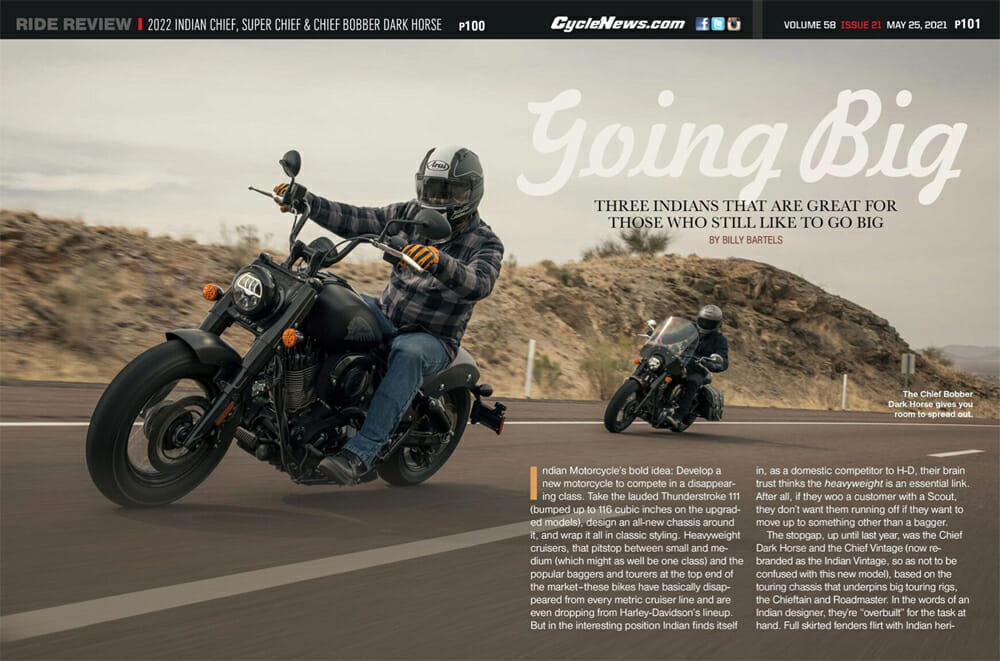| May 29, 2021
Three Indians that are great for those who still like to go big.
 The Chief Bobber Dark Horse gives you room to spread out.
The Chief Bobber Dark Horse gives you room to spread out.
By Billy Bartels
Indian Motorcycle’s bold idea: Develop a new motorcycle to compete in a disappearing class. Take the lauded Thunderstroke 111 (bumped up to 116 cubic inches on the upgraded models), design an all-new chassis around it, and wrap it all in classic styling. Heavyweight cruisers, that pitstop between small and medium (which might as well be one class) and the popular baggers and tourers at the top end of the market—these bikes have basically disappeared from every metric cruiser line and are even dropping from Harley-Davidson’s lineup. But in the interesting position Indian finds itself in, as a domestic competitor to H-D, their brain trust thinks the heavyweight is an essential link. After all, if they woo a customer with a Scout, they don’t want them running off if they want to move up to something other than a bagger.
The stopgap, up until last year, was the Chief Dark Horse and the Chief Vintage (now rebranded as the Indian Vintage, so as not to be confused with this new model), based on the touring chassis that underpins big touring rigs, the Chieftain and Roadmaster. In the words of an Indian designer, they’re “overbuilt” for the task at hand. Full skirted fenders flirt with Indian heritage, and they rock the same powerplant, but compared to the new Chief, they’re basically polar opposites. The old Chiefs were stripped down to a “cruiser” level from their touring roots, while the new Chief is built up, from a minimalist chassis, wrapping the hefty powerplant in as little chassis as possible. In the case of the new Super Chief, it’s actually built up to be a light tourer. Same idea, different direction.
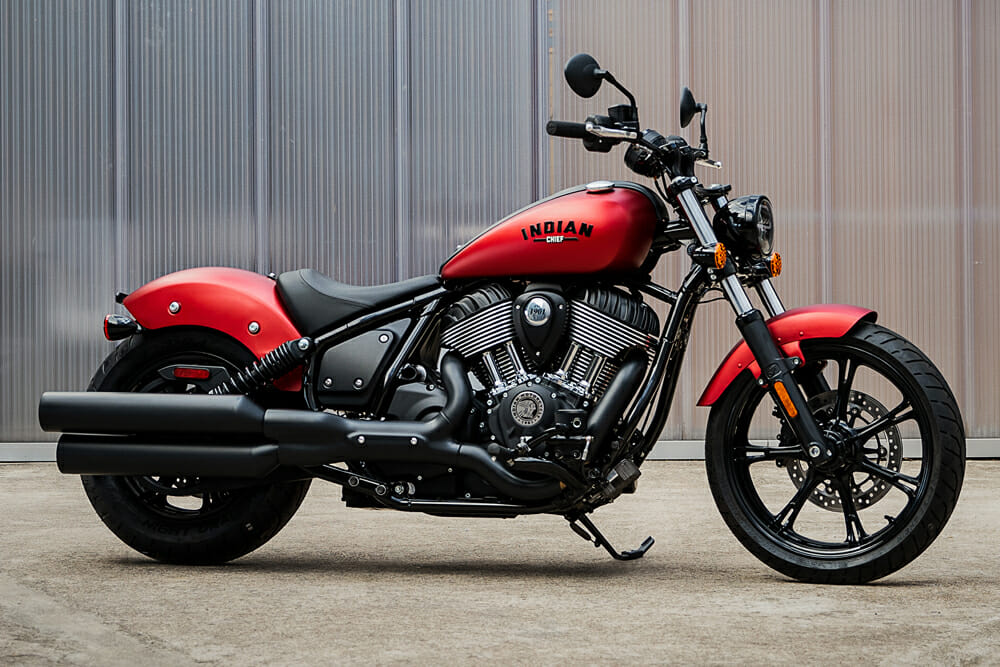 The Indian Chief offers classic, simple and clean styling.
The Indian Chief offers classic, simple and clean styling.
This Chief is a fantasy retro creation. A “what if” Indian had survived past the early 1950s and got to do battle with “that other American brand” for the other half of the 20th century. Remember those Chiefs of recent history? They wore the full fenders of the Indian Motorcycle (sic) Company’s twilight. The new Chief wears looks not ever found on a past factory Indian, with brief bobbed fenders and sculpted seats. That said, there are fabulous styling cues taken from Indians past and present, like the sinuous S-curve to the frame downtube or the tank or the slightly bulging slab-sided tank that crosses the rounded touring bikes and the very square Scout. Starting with the base Chief, which imagines Indian making a ’70s-’80s factory custom, with mid-mount controls, an aggressive stance, and a 19-inch front mag wheel. Going back in time, the Chief Bobber is, frankly, a little more like a ’60s chopper with high bars but “retaining” what would have been standard fare: laced 16-inch rims and full-coverage “tins” on the suspension components. Super Chief goes all the way back to the 1950s with an all-purpose motorcycle sporting full floorboards, windshield and light luggage. The Super Chief might be the only bike in history to try to be both a bobber and a dresser at the same time. While the “retroness” is a little idiosyncratic, all the versions of the Chief are stylish, clean and well put-together. Minimalist and elemental, like a good cruiser should be.
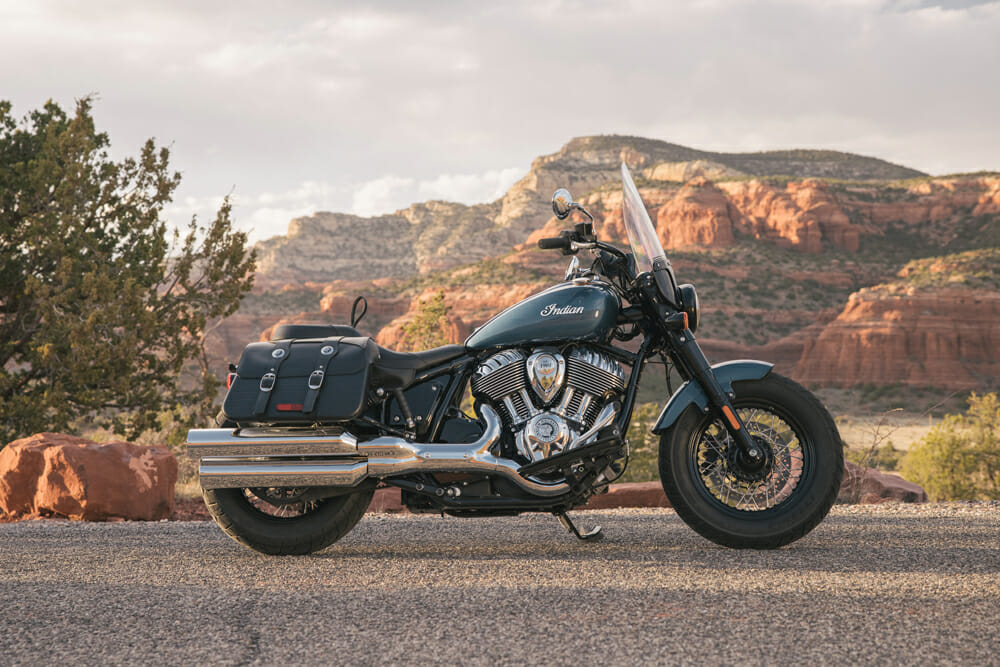 Super Chief designers said this bike is intended to be like the ’50s big bikes that did all the things, including touring.
Super Chief designers said this bike is intended to be like the ’50s big bikes that did all the things, including touring.
2022 Indian Chief
Yavapai County, Arizona, home to some of the best scenic, twisty roads in the nation, was the backdrop for our testing. The base model Chief was where my testing started. Despite being the “basic” model, the Chief is also the most unique. Mid-mount rider footpegs, bare suspension (bereft of steel tins) and a 19-inch front wheel combine for a ride (and look) quite unlike the other versions. Since I was starting at the base, my tester had the standard 111 cubic-inch Thunderstroke air-cooled, pushrod V-twin motor and the basic LCD/analog display. All three models come in a base version, and a high-spec version (either Dark Horse or Limited) with upgraded finishes, an LED touchscreen display, and Indian’s bored-out 116 cubic-inch Thunderstroke motor.
The Chief is a light lift off the sidestand, with high and tight pegs just in front of the rider, but with low-rise bars a decent stretch forward. The result is an aggressive “attack” riding position, which should fit a range of riders, though riders over six-feet may feel cramped, at six feet with a 33-inch inseam I was fine. The 19-inch cast front mag wheel, mated to a 46mm fork at a 29-degree rake projects solidity (if not nimbleness) when changing directions. The entire chassis is super stable and forgiving. As on Indians of ages past, the air cleaner is on the left, where it belongs, and not intrusive to your knees.
As much as the upgraded digital touchscreen display on the Dark Horse and Limited versions deserves to be talked about, the basic LCD has a large, readable display with all the usual information, but also tachometer, ambient air temperature, fuel economy and range, and gear indicator. Same goes for the standard 111-inch engine. Mated to a three-mode engine management system (EMS), the torquey lump can go from hair-trigger enthusiasm in Sport mode, to a more laid-back standard mode. There’s also tour mode, but we’re not sure what that’s for. In the presentation it was touted as beginner-friendly, but the lag between throttle input and action is so long, that you have time to twist it harder while waiting for a response, which doesn’t feel like the most beginner-friendly thing when the beefy motor actually engages. We only tried that briefly. Sport is great if you like ultimate throttle control with a hard hit and instant changes, but it lacks subtlety and needs focus. Standard has a soft hit and is a great cruising or touring mode, good for taking in the scenery and not getting jostled when getting on or off the throttle.
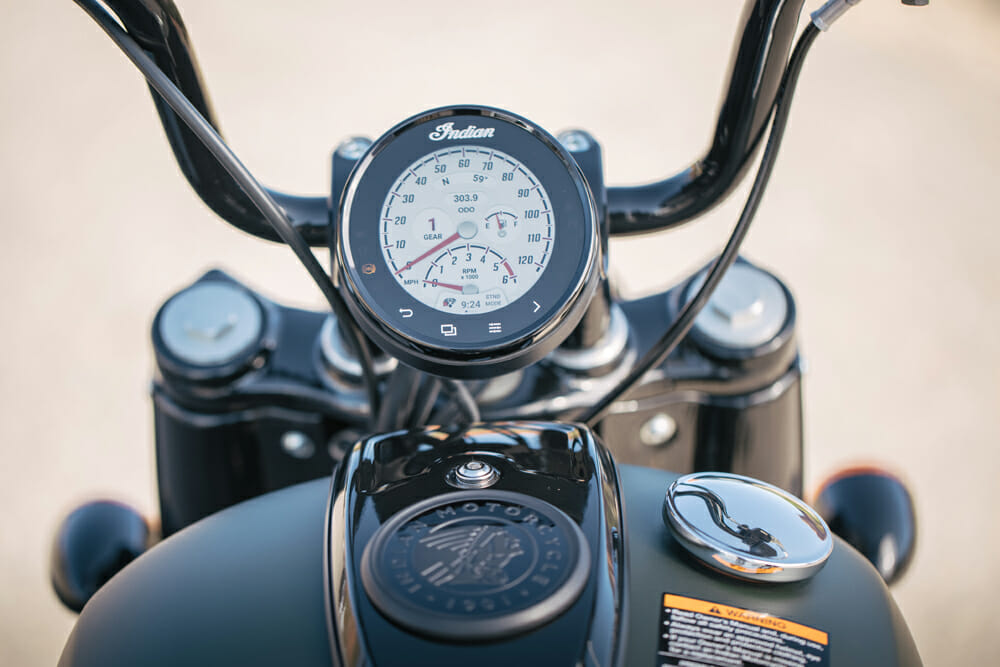 Two different faces (above and below) of the Chief, changeable at the push of a button.
Two different faces (above and below) of the Chief, changeable at the push of a button.
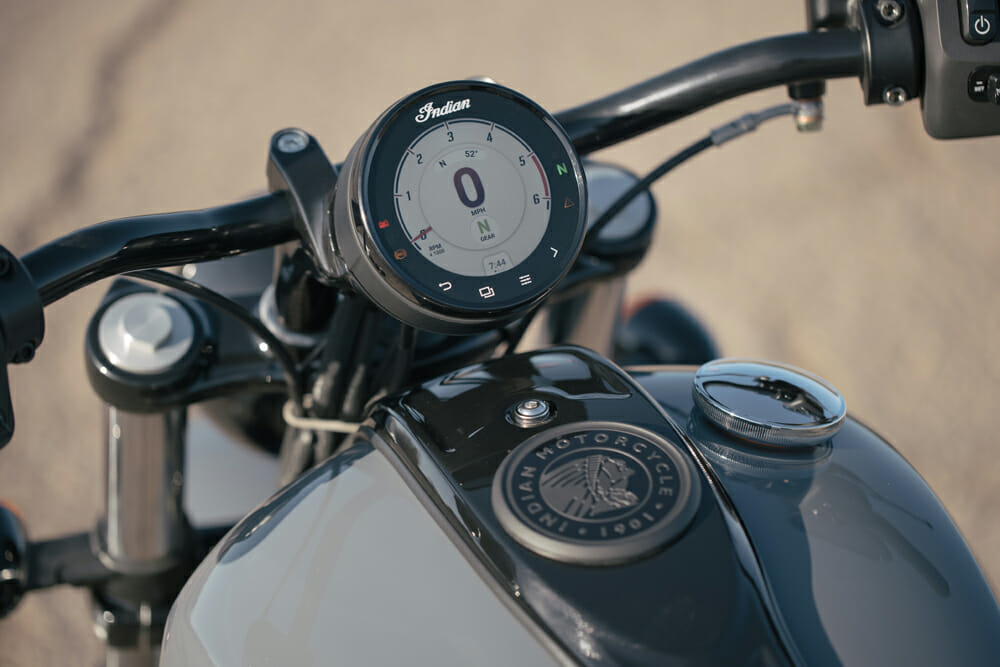
2022 Indian Chief Bobber Dark Horse
Stepping up to the Chief Bobber, we went from a tight rider triangle to a rather open one. While the Chief was good for most riders, the Chief Bobber probably has a floor for rider height around five-foot three inches. Forward pegs and high bars are what distinguish the Bobber from the Chief ergonomically, while 16-inch wire rims front and rear change it functionally, and steel “tins” on the front and rear suspension change it aesthetically. We got the Dark Horse version, which means matte paint, that sweet 116-inch motor, and a four-inch round touchscreen with Ride Command.
Sixteen-inch wheels provide a more active feel, dropping into corners more readily, but also not planting as solidly as the 19-inch on the base model. Add to that the wide mini ape bars giving more leverage on the front, and it was very much like riding a different motorcycle. Which is an important note on this trio of motorcycles: They may not look very different, but they ride and feel very differently; and all the parts are interchangeable, so you can Frankenstein up a collection of all your favorite parts.
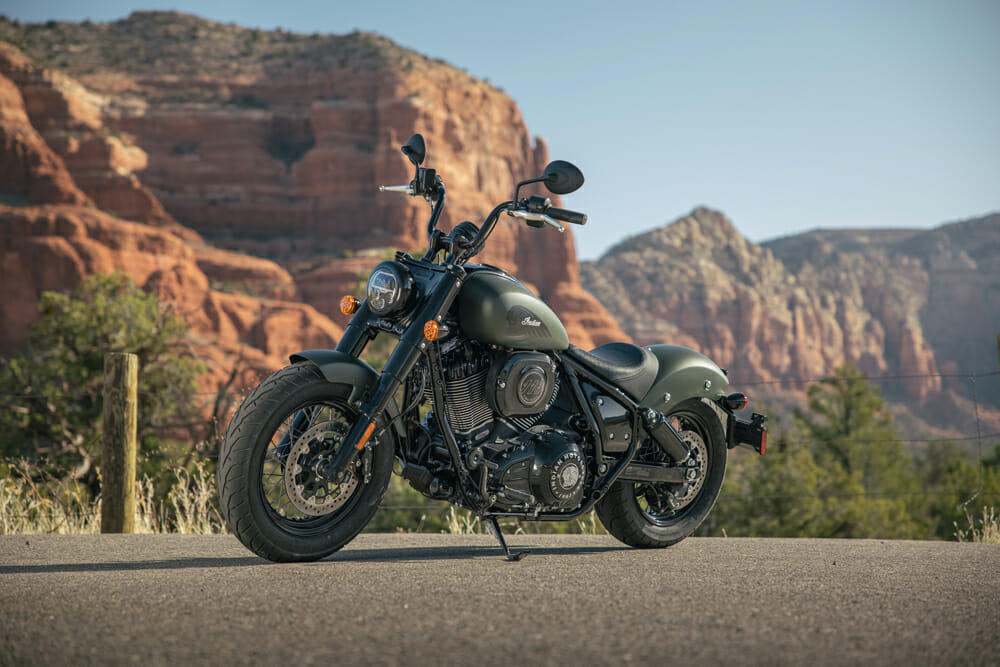 Dark Horse version of the Bobber means you get matte paint, that sweet 116-inch motor, and a four-inch round touchscreen with Ride Command.
Dark Horse version of the Bobber means you get matte paint, that sweet 116-inch motor, and a four-inch round touchscreen with Ride Command.
The four-inch touchscreen is a perfect use of technology on a retro-themed motorcycle. Packing a ton of features into its tiny chassis, the gauge does all the usual gauge things (controlled via touch, of course), but is configurable for layout and will also connect with your phone and helmet Bluetooth for music and calls, or give you turn-by-turn navigation with Indian’s proprietary system. In rural Arizona, it was a little spotty getting it to connect at times, and if it just told me that, it would be okay. Instead, it would say it can’t find the address, which was confusing when it would later find the address.
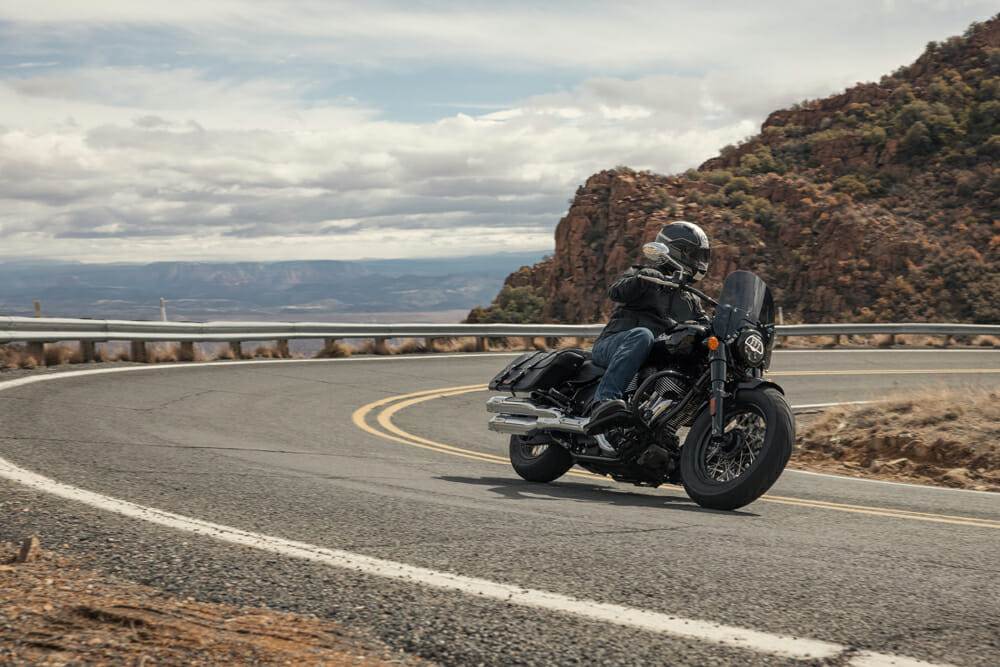 The Super Chief we rode was equipped with a smoked abbreviated windshield, which, if anything, was better than the stock shield, staying out of sightlines and keeping wind off the rider’s chest.
The Super Chief we rode was equipped with a smoked abbreviated windshield, which, if anything, was better than the stock shield, staying out of sightlines and keeping wind off the rider’s chest.
2022 Indian Super Chief
Designers said it’s intended to be like the ’50s big bikes that did all the things, including touring. But because at its core, this bike is a bobber-style bike, it’s like something that’s been stripped and built back up. Something that stands out on the Super Chief like on none of the other models is the way the chrome pipe from the front cylinder wraps around the bottom of the motor, showcasing the handsome mill. The upgraded version of the Super Chief isn’t the demure Dark Horse of the other two Chiefs, rather it’s the Limited. While it still has the rich blacks, they’re glossier, and it adds heaping spoonsful of chrome as well. The Super shares the “sleeved” suspension components of the bobber, adding to its retro appeal.
With the best overall ergonomics of the bunch, it may not win the attitude department, but it’ll improve yours after a long day in the saddle. Nobody thinks they’re into floorboards, until they spend a few hours on them. And these are long and luxurious floorboards, capable of quite a few riding positions; anywhere from stretched out to upright. The beach bars are close to the rider, but wide, making for a very relaxed riding position. The example we rode was equipped with a smoked abbreviated windshield, which, if anything, was better than the stock shield, staying out of sightlines and keeping wind off the rider’s chest.
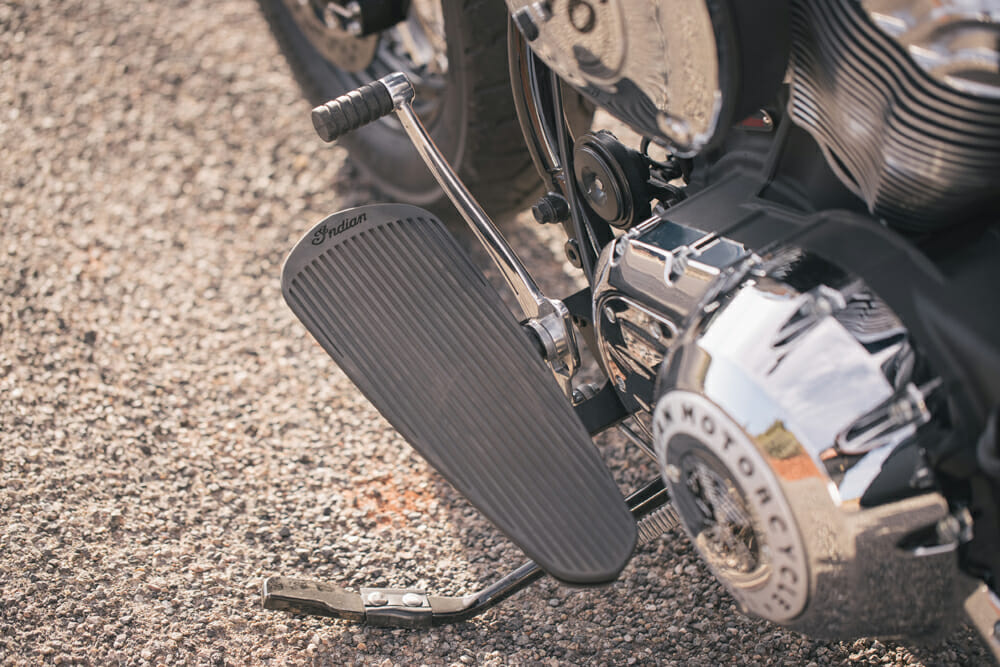 Super Chief’s long, comfy floorboards. No heel shifter though.
Super Chief’s long, comfy floorboards. No heel shifter though.
I mention the Limited here, not because I rode it, but because with the expanded capabilities of the touchscreen, this would be a fantastic sleeper touring bike. Especially for smaller or newer riders, who won’t want the bulk of a full-on touring rig. The bags are a bit small, but strap on a back seat bag and tank bag, and you’re good to go coast-to-coast. The saddlebags also have a nice cut-out on the right side to accommodate the exhaust, while dipping into the saddlebag as little as possible, and also maintaining the lines of the machine. I rode the base model Super Chief, and missed the extra touchscreen features in my face, and the extra ponies in the motor. The 111 Thunderstroke is capable and fun, but the added oomph of the 116 is addictive.
Accessories
There were several accessory-laden bikes peppered into our test units, as well. I’ve already mentioned the altered windshield on my Super Chief, but I also got to ride a Chief with Indian’s Stage Two kit on it, as well as the forward foot controls from the Bobber. With a massive intake snorkel replacing the flattened air cleaner (on the left side, because it’s an Indian), I was eager to see if it interfered with my knees at all, but it seems perfectly suited to a range of riders. Shorter ones slip underneath it, while longer legged folk (that would be me) just reach around without difficulty. Ergonomic concerns alleviated; I was glad I gave it a shot. So, the irony (at least for me) is that while the expanded capabilities of the motor made for better high-performance riding, it actually made me lazier. The way it pulls from even lower rpm makes me want to lug it and short shift. Most of the time, on all these bikes, I rode around in Tour mode, but the Stage 2, in sport, would just let you lug the motor and still have a nice hit when you twist the throttle. Lazy, but wicked. The enhanced 116 doesn’t make some sort of insane top-end rush, but just seems to boost power in all ranges.
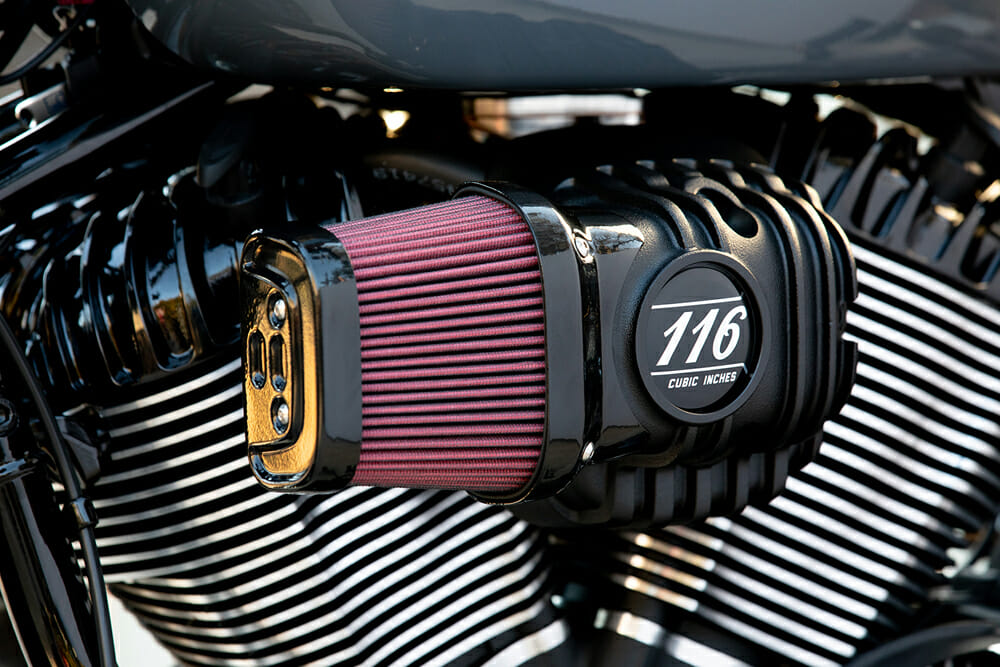 Some of the Dark Horse’s accessory, include upgraded intake and exhaust slip-ons, cams, fuel injection components and revised mapping.
Some of the Dark Horse’s accessory, include upgraded intake and exhaust slip-ons, cams, fuel injection components and revised mapping.
More To Come
Indian promises that there are more models coming for this platform (which is promised to have about a 10-year lifespan), but as it is now, with just three closely connected models, they all kind of look the same. While I wouldn’t normally bring up other manufacturer’s bikes, Indian basically invited it with a constant stream of comparison to the Softail. The untrained eye would have trouble understanding that a Fat Boy and a Fat Bob are basically the same bikes with some parts swapped out, the same viewer would have no trouble telling that all the Chiefs are the same bike. They feel different (which is great), they have tons of interchangeable parts (also fabulous), but with the same sheet metal and overall lines they look very similar. In other words, if you’re not into a bobbed-style retro custom, you’re probably not going to buy a Chief, regardless of how much you like the ride.
But! The upside of all this crossover between the versions is that all of the parts are cross-compatible. Like the Chief, but really want forward controls? Change them, as with the Stage 2 Chief we rode. Or, if you’d rather have the sleek, covered shocks on the Bobber, but want the drag bars from the Chief? Swap ’em out. Each of the versions works well on its own but can also be recombined to your heart’s content.
In a rapidly shrinking cruiser market, is consolidation a genius move, or is it suicide? Star, the last heavyweight contender to go after Harley’s crown doesn’t even exist any longer, with its former models fading away in Yamaha’s larger lineup. It’s a bold move, and some would argue needed, to keep loyalists from drifting if their tastes call for something “heavyweight” (but not too heavyweight). CN
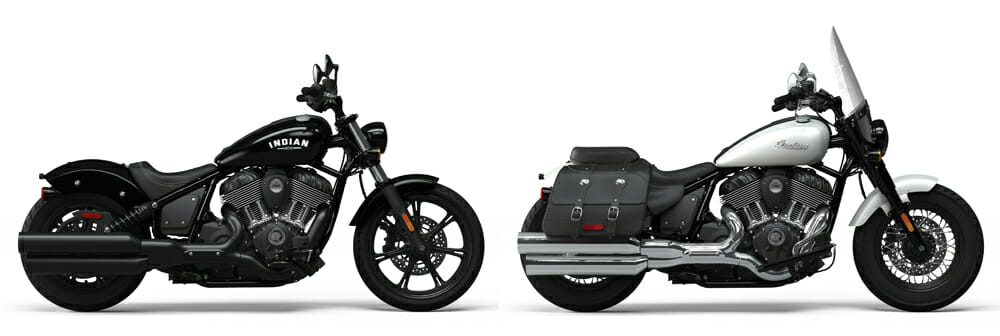
2022 Indian Chief / Super Chief Specifications
| MSRP: |
$14,499/ $18,499 |
| Engine: |
Thunderstroke 111, 4-stroke, V-twin |
| Bore x Stroke: |
101mm x 113mm |
| Compression Ratio: |
9.5:1 |
| Displacement: |
1811cc |
| Peak Torque (claimed): |
108 ft-lb @ 3200 rpm |
| Fueling System: |
EFI, 54mm throttle body |
| Exhaust: |
Dual |
| Transmission: |
6-speed |
| Front Suspension: |
Telescopic fork, 46mm |
| Rear Suspension: |
Dual shock w/ adjustable preload |
| Front-Wheel Travel: |
5.2 in. |
| Rear-Wheel Travel: |
3.0 in. |
| Front Brake: |
Single 300mm floating disc w/ 4-piston caliper |
| Rear Brake: |
Single 300mm floating disc w/ 2-piston caliper |
| Front Wheel: |
Cast Black 19 in. x 3.5 in. / Wire Spoke 16 in. x 3 in. |
| Rear Wheel: |
Cast Black 16 in. x 5 in. / Wire Spoke 16 in. x 5 in. |
| Front Tire: |
130/60-19 in. Pirelli Night Dragon / 130/90-16 in. Pirelli Night Dragon |
| Rear Tire: |
180/65-16 in. Pirelli Night Dragon |
| Ground Clearance: |
4.9 in. |
| Seat Height: |
26.0 in. / 26.2 in. |
| Wheelbase: |
64.0 in. |
| Rake/Trail: |
29°/5.2 in. |
| Weight (curb, claimed): |
670 lbs. / 739 lbs. |
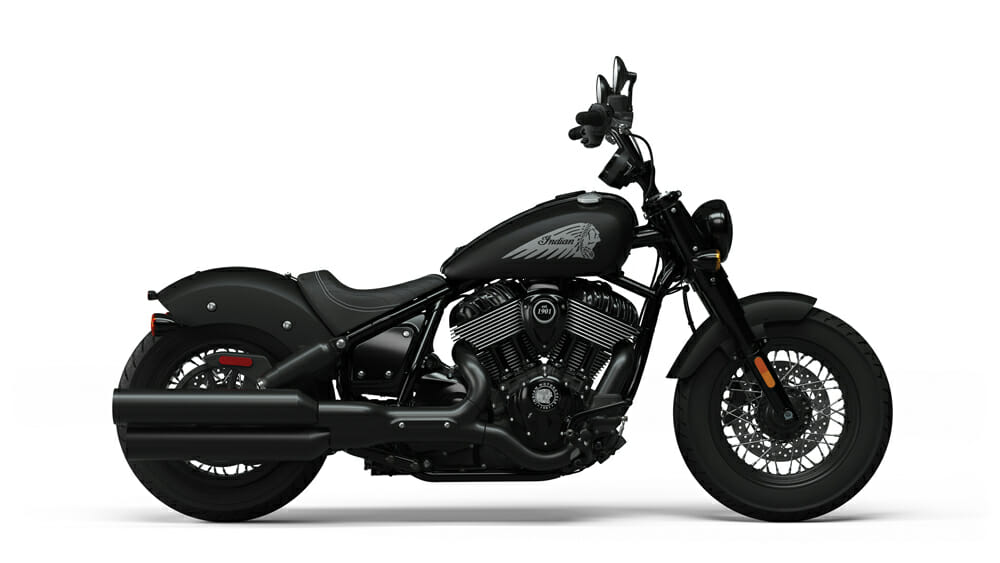
2022 Indian Chief Bobber Dark Horse Specifications
| MSRP: |
$18,999 |
| Engine: |
Thunderstroke 116, 4-stroke, V-twin |
| Bore x Stroke: |
103.2mm x 113mm |
| Compression Ratio: |
11.0:1 |
| Displacement: |
1890cc |
| Peak Torque (claimed): |
120 ft-lb @ 2900 rpm |
| Fueling System: |
EFI, 54mm throttle body |
| Exhaust: |
Dual |
| Transmission: |
6-speed |
| Front Suspension: |
Telescopic fork, 46mm |
| Rear Suspension: |
Dual shock w/adjustable preload |
| Front-Wheel Travel: |
5.2 in. |
| Rear-Wheel Travel: |
3.0 in. |
| Front Brake: |
Single 300mm floating disc w/ 4-piston caliper |
| Rear Brake: |
Single 300mm floating disc w/ 2-piston caliper |
| Front Wheel: |
Wire Spoke 16 in. x 3 in. |
| Rear Wheel: |
Wire Spoke 16 in. x 5 in. |
| Front Tire: |
130/90-19 in. Pirelli Night Dragon |
| Rear Tire: |
180/65-16 in. Pirelli Night Dragon |
| Ground Clearance: |
4.9 in. |
| Seat Height: |
26.0 in. |
| Wheelbase: |
64.0 in. |
| Rake/Trail: |
29°/5.2 in. |
| Weight (curb, claimed): |
694 lbs. |
